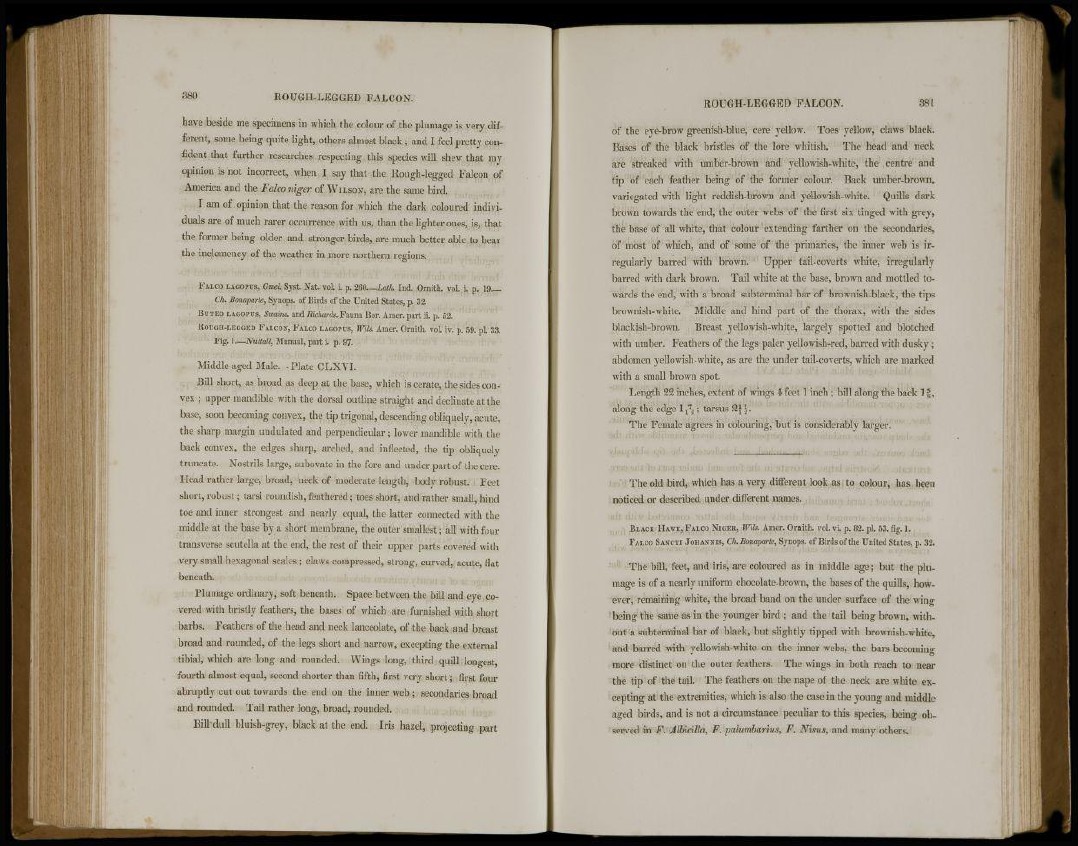
380 ROUGH-LEGGED FALCON.
have beside me specimens in which the colour of the plumage is very different,
some being quite light, others almost black ; and I feel pretty confident
that further researches respecting this species will shew that my
opinion is not incorrect, when I say that the Rough-legged Falcon of
America and the Falco niger of W I L S O N , are the same bird.
I am of opinion that the reason for which the dark coloured individuals
are of much rarer occurrence with us, than the lighter ones, is, that
the former being older and stronger birds, are much better able to bear
the inclemency of the weather in more northern regions.
FALCO LAGOPUS, Gmel. Syst. Nat. vol. i. p. 260.—Lath. Ind. Ornith. vol. i. p. 19.—
Ch. Bonaparte, Synops. of Birds of the United States, p. 32.
BUTEO LAGOPUS, Swains, and Ricliurds. Fauna Bor. Amer. part ii. p. 52.
HOUGH-LEGGED FALCON, FALCO LAGOPUS, Wils. Amer. Ornith. vol. iv. p. 59. pi. 33.
Fig. 1—Nulla!!, Manual, parti, p. 97-
Middle aged Male. -Plate CLXVI.
Bill short, as broad as deep at the base, which is cerate, the sides convex
; upper mandible with the dorsal outline straight and decimate at the
base, soon becoming convex, the tip trigonal, descending obliquely, acute,
the sharp margin undulated and perpendicular; lower mandible with the
back convex, the edges sharp, arched, and inflected, the tip obliquely
truncate. Nostrils large, subovate in the fore and under part of the cere.
Head rather large, broad, neck of moderate length, body robust. Feet
short, robust; tarsi roundish, feathered; toes short, and rather small, hind
toe and inner strongest and nearly equal, the latter connected with the
middle at the base by a short membrane, the outer smallest; all with four
transverse scutella at the end, the rest of their upper parts covered with
very small hexagonal scales ; claws compressed, strong, curved, acute, fiat
beneath.
Plumage ordinary, soft beneath. Space between the bill and eye covered
with bristly feathers, the bases of which are furnished with short
barbs. Feathers of the head and neck lanceolate, of the back and breast
broad and rounded, of the legs short and narrow, excepting the external
tibial, which are long and rounded. Wings long, third quill longest,
fourth almost equal, second shorter than fifth, first very short; first four
abruptly cut out towards the end on the inner web; secondaries broad
and rounded. Tail rather long, broad, rounded.
Bill'dull bluish-grey, black at the end. Iris hazel, projecting part
of the eye-brow greenish-blue, cere yellow. Toes yellow, claws black.
Bases of the black bristles of the lore whitish. The head and neck
are streaked with umber-brown and yellowish-white, the centre and
tip of each feather being of the former colour. Back umber-brown,
variegated with light reddish-brown and yellowish-white. Quills dark
brown towards the end, the outer webs of the first six tinged with grey,
the base of all white, that colour extending farther on the secondaries,
of most of which, and of some of the primaries, the inner web is irregularly
barred with brown. Upper tail-coverts white, irregularly
barred with dark brown. Tail white at the base, brown and mottled towards
the end, with a broad subterminal bar of brownish-black, the tips
brownish-white. Middle and hind part of the thorax, with the sides
blackish-brown. Breast yellowish-white, largely spotted and blotched
with umber. Feathers of the legs paler yellowish-red, barred with dusky ;
abdomen yellowish-white, as are the under tail-coverts, which are marked
with a small brown spot.
Length 22 inches, extent of wings 4 feet 1 inch ; bill along the back 11,
along the edge 1'^"; tarsus 2f §.
The Female agrees in colouring, but is considerably larger.
The old bird, which has a very different look as to colour, has been
noticed or described under different names.
BLACK HAWK, FALCO NIGER, Wils. Amer. Ornith. vol. vi. p. 82. pi. 53. fig. 1.
FALCO SANCTI JOHANNIS, Ch. Bonaparte, Synops. of Birds of the United States, p. 32.
The bill, feet, and iris, are coloured as in middle age; but the plumage
is of a nearly uniform chocolate-brown, the bases of the quills, however,
remaining white, the broad band on the under surface of the wing
being the same as in the younger bird ; and the tail being brown, without
a subterminal bar of black, but slightly tipped with brownish-white,
and barred with yellowish-white on the inner webs, the bars becoming
more distinct on the outer feathers. The wings in both reach to near
the tip of the tail. The feathers on the nape of the neck are white excepting
at the extremities, which is also the case in the young and middle
aged birds, and is not a circumstance peculiar to this species, being observed
in F. Albicilla, F. palumbarius, F. Nisus, and many others.